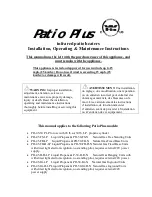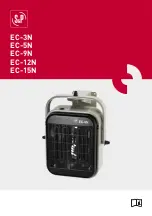
Page | 33
Cool Energy inverTech Manual v6.6 2020 ©
Section 4
Commissioning
•
Ensure all pipes have been flushed with cleaner and are free of debris in accordance with Part L
Building Regulations. (
Part L
refers to the
Domestic Heating Compliance Guide
. This states that the
minimum provision in new and existing dwellings is: Thorough cleaning and flushing out before
installing a new heating appliance. During final fill add the corrosion and scale formulation / Glycol
as required.
•
Water flow should be checked either by a flow metering device either fitted permanently or
temporarily to the system. Or measuring the temperature differential between the flow and return
pipes when the heat pump is running. The temperature differential should not exceed 5 degrees C.
The heat pump itself does also incorporate a flow switch on the return pipe. If a low flow condition
is detected, alarm code
AL137
willbe displayed on the controller and will not reset until the flow has
been restored.
•
Visually check installation to ensure all pipework is complete and insulation is applied where
required
•
Check all electrical connections have been made and tested according to BS7671:2018
•
Ensure system is filled and pressure is between 1 & 2 bar
•
Ensure all system filters are free from debris
•
Check all air has been vented from the system
•
Turn all external heating controls and thermostats to on positions
•
Activate the heat pump with the Carel control screen
•
Check operation of external controls by turning zones on and off and thermostats up and down
•
Allow heat pump to reach set temperatures for each zone
•
Ensure heat pump settings are correct according to the factory defaults provided in Section 3.
•
Set timeclocks and temperature settings to optimise efficiency for homeowner
(Weather compensation mode is recommended)
•
Fill in benchmark form with the installation details (p33)
•
Demonstrate the system to the homeowner
Service & Maintenance
–
Service Engineer
Inspection and Service
Cool Energy air source heat pumps are designed and built to provide long life and performance, when installed
and operated properly under normal conditions. Periodic inspections are important to keep your heat pump
running safely and efficiently.
The basic requirements are:
•
Clean the outdoor heat exchanger
•
Straighten any evaporator fins with a fin comb if required
•
Visual inspection for oil or leaks
•
Test the primary system water with a refractometer to ensure adequate glycol concentrate
•
Check the integrity of the pipework insulation
•
Check for loose electrical connections
•
Check heat pump control settings are correct for best performance
•
Check system controls are set for best performance
•
Check compressor operating current
•
Complete service record (p34)





































